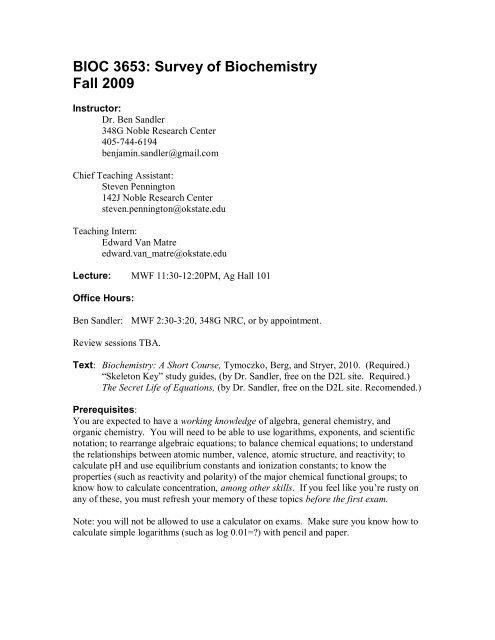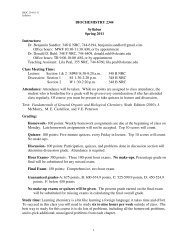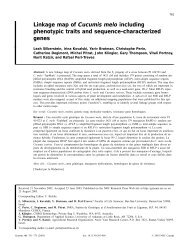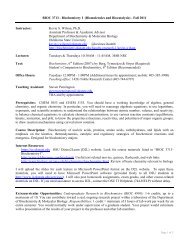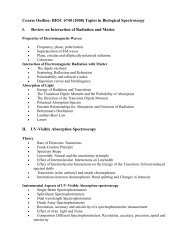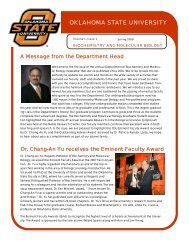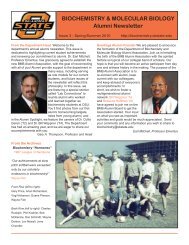BIOC 3653: Survey of Biochemistry - Biochemistry and Molecular ...
BIOC 3653: Survey of Biochemistry - Biochemistry and Molecular ...
BIOC 3653: Survey of Biochemistry - Biochemistry and Molecular ...
You also want an ePaper? Increase the reach of your titles
YUMPU automatically turns print PDFs into web optimized ePapers that Google loves.
<strong>BIOC</strong> <strong>3653</strong>: <strong>Survey</strong> <strong>of</strong> <strong>Biochemistry</strong><br />
Fall 2009<br />
Instructor:<br />
Dr. Ben S<strong>and</strong>ler<br />
348G Noble Research Center<br />
405-744-6194<br />
benjamin.s<strong>and</strong>ler@gmail.com<br />
Chief Teaching Assistant:<br />
Steven Pennington<br />
142J Noble Research Center<br />
steven.pennington@okstate.edu<br />
Teaching Intern:<br />
Edward Van Matre<br />
edward.van_matre@okstate.edu<br />
Lecture: MWF 11:30-12:20PM, Ag Hall 101<br />
Office Hours:<br />
Ben S<strong>and</strong>ler: MWF 2:30-3:20, 348G NRC, or by appointment.<br />
Review sessions TBA.<br />
Text: <strong>Biochemistry</strong>: A Short Course, Tymoczko, Berg, <strong>and</strong> Stryer, 2010. (Required.)<br />
“Skeleton Key” study guides, (by Dr. S<strong>and</strong>ler, free on the D2L site. Required.)<br />
The Secret Life <strong>of</strong> Equations, (by Dr. S<strong>and</strong>ler, free on the D2L site. Recomended.)<br />
Prerequisites:<br />
You are expected to have a working knowledge <strong>of</strong> algebra, general chemistry, <strong>and</strong><br />
organic chemistry. You will need to be able to use logarithms, exponents, <strong>and</strong> scientific<br />
notation; to rearrange algebraic equations; to balance chemical equations; to underst<strong>and</strong><br />
the relationships between atomic number, valence, atomic structure, <strong>and</strong> reactivity; to<br />
calculate pH <strong>and</strong> use equilibrium constants <strong>and</strong> ionization constants; to know the<br />
properties (such as reactivity <strong>and</strong> polarity) <strong>of</strong> the major chemical functional groups; to<br />
know how to calculate concentration, among other skills. If you feel like you’re rusty on<br />
any <strong>of</strong> these, you must refresh your memory <strong>of</strong> these topics before the first exam.<br />
Note: you will not be allowed to use a calculator on exams. Make sure you know how to<br />
calculate simple logarithms (such as log 0.01=?) with pencil <strong>and</strong> paper.
D2L website:<br />
https://oc.okstate.edu<br />
The D2L site is an essential part <strong>of</strong> this class. It is your responsibility to check this site<br />
regularly for announcements, homeworks, grades, etc. The Powerpoint files for lectures<br />
will also be posted here. Keep your eye on the site as additional resources are added!<br />
Lecture Videos:<br />
Videos <strong>of</strong> the lectures will be available through the course website. (Instructions on how<br />
to view these videos will also be posted.)<br />
Homeworks:<br />
Homework problems will be regularly assigned <strong>and</strong> posted on the D2L website. In<br />
general, they will be assigned on a Friday <strong>and</strong> due on the following Friday. As usual,<br />
write clearly- unintelligible responses will receive a zero. These homeworks will be spotgraded<br />
(i.e., we will pick a subset <strong>of</strong> questions to grade on each homework,) <strong>and</strong> you will<br />
also receive some points for completing all the questions, even if your answers are<br />
incorrect.<br />
You are encouraged to work collaboratively on the homeworks. But, do not copy other<br />
people’s homeworks- even when you work together, your final answer must be your own,<br />
written in your own words.<br />
In order to be considered complete, answers to homework questions must show all your<br />
work, complete with your reasoning <strong>and</strong> calculations, <strong>and</strong> be presented in a neat <strong>and</strong><br />
organized fashion. Remember, the goal is not merely to learn the material, but also to<br />
learn how to communicate your knowledge effectively.<br />
Exams:<br />
There will be four exams, 50 minutes each, during the semester. You will need to bring<br />
your own orange Scantron sheet to each exam. For some exams, you may also need a<br />
non-programmable, single-line scientific calculator. Be sure to write clearlyunintelligible<br />
responses will get a zero!<br />
All exams are closed-book, closed-notes. Use <strong>of</strong> any notes, either on paper or on a<br />
calculator, is not permitted <strong>and</strong> will be considered cheating, <strong>and</strong> dealt with accordingly.<br />
Use <strong>of</strong> a calculator on a non-calculator exam will also be considered cheating.<br />
The lowest score on a midterm will be dropped. The final exam will be 2 hours long, <strong>and</strong><br />
will cover information from the entire course.<br />
Makeup exams:<br />
There will be no makeup exams. If you miss an exam, it will be given the same grade as<br />
your final exam grade.
Grading Scheme:<br />
Letter grades will be determined using the following scheme. The pr<strong>of</strong>essor reserves the<br />
right to lower these cut<strong>of</strong>fs for specific exams, if necessary. Note: the carets are “greater<br />
than” signs. Thus 97 is an A, <strong>and</strong> 97.1 is an A+.<br />
>97 A+ >77 C+ > 50 F+<br />
>93 A >73 C >30 F<br />
>89.9 A- >69.9 C- 87 B+ >67 D+<br />
>83 B >63 D<br />
>79.9 B- >59.9 D-<br />
Your grade will be a weighted average <strong>of</strong> your letter grades on exams <strong>and</strong> assignments.<br />
(To average letter grades, convert them to numbers using 12=A+, 11=A, 10=A-, 9=B+,<br />
etc.) This is why we use the F+ grade: it enables students to pull up their grade if they<br />
fall just below the boundary for passing. Do not use your numerical grades to calculate<br />
your grade in the class! Always convert them to letter grades first, using the scheme<br />
shown above, or using the curved grading schemes posted for curved exams.<br />
Three highest exams <strong>of</strong> four: 20% each 60%<br />
Homeworks 20 points each 10% total<br />
Comprehensive Final Exam 30%<br />
Total 100%<br />
For example, suppose a student got a 96 (A) on her homework, an 83 (B-), a 78 (C+), a<br />
92 (A-), <strong>and</strong> a 67 (D) on her midterms, <strong>and</strong> a 89 (B+) on the final. Her final grade would<br />
be:<br />
0.1 x (A) + 0.6 x (average <strong>of</strong> B-, C+, <strong>and</strong> A-) + 0.3 (B+) =<br />
0.1 x (11) + 0.6 (7 + 6 + 10) /3 + 0.3 x (9) = 1.1 + 4.6 + 2.7 = 8.4 = B<br />
If you want to calculate a rough estimate <strong>of</strong> your current grade, you can do it like this:<br />
[0.1 x (average HW letter grade thus far) + 0.6 x (average <strong>of</strong> midterm letter grades)]/0.7<br />
= current grade.<br />
Students <strong>of</strong>ten want to calculate what grade they must make on the final in order to make<br />
a particular grade in the class. You can calculate that using the following formula <strong>and</strong><br />
solving for Y:<br />
0.1 x (HW grade) + 0.6 x (avg <strong>of</strong> midterm grades) + 0.3 x Y = desired letter grade.
Academic dishonesty or misconduct:<br />
Students are, as always, expected to follow the rules. Academic dishonesty or<br />
misconduct is defined in the OSU Policy <strong>and</strong> Procedures letter 2-0822. If you are found<br />
to have engaged in dishonesty or misconduct, the punishment will be at minimum an F on<br />
an exam or assignment, up through an F in the course or worse.<br />
Disabilities:<br />
If you have special needs, please contact Dr. S<strong>and</strong>ler as soon as possible so that we can<br />
work with you <strong>and</strong> the Office <strong>of</strong> Disabled Student Services (326 Student Union) to<br />
provide reasonable accommodations for you.<br />
How to Make an A in This Class:<br />
<strong>Biochemistry</strong> is very different from many <strong>of</strong> the courses you’ve taken before. You need<br />
to learn a great deal <strong>of</strong> material, <strong>and</strong> underst<strong>and</strong> how it all fits together. The ability to<br />
think <strong>and</strong> problem solve will be very important, not only because your exams will ask<br />
you “puzzle questions” about biochemistry, but because that kind <strong>of</strong> thinking will help<br />
you to organize <strong>and</strong> underst<strong>and</strong> all <strong>of</strong> the facts that you need to learn. Merely being able<br />
to “plug <strong>and</strong> chug” an equation or memorize a graph will not enable you to do well in<br />
this class! It is essential that you genuinely underst<strong>and</strong> what the material means. I have<br />
written some course materials, available through the D2L site, that will help you do this.<br />
Make flash cards for all the facts that you encounter in class, with a question on one side,<br />
<strong>and</strong> the answer on the back. Many students have found it helpful to make a second set <strong>of</strong><br />
flash cards, each <strong>of</strong> which has a diagram on one side, <strong>and</strong> an annotated copy <strong>of</strong> the same<br />
diagram on the back. (For example, it might have a picture <strong>of</strong> the Citric Acid Cycle on<br />
the front, with explanations on the back <strong>of</strong> what’s going on at each step.) Or, make “idea<br />
maps” showing how the ideas are connected together. (I will show you some <strong>of</strong> these in<br />
class, <strong>and</strong> will increasingly leave it to you to make your own as the class goes on.) Use<br />
construction paper to make tokens indicating different biomolecules, <strong>and</strong> use these tokens<br />
to act out the processes you learn about in class.<br />
Many students assume that they can do badly on the midterms <strong>and</strong> bring their grade up if<br />
they do well on the final. This generally will not work, because the final only counts for<br />
30% <strong>of</strong> your grade. Don’t wait until the last minute to do well in this course!<br />
What to Study:<br />
You are only required to read the sections <strong>of</strong> the textbook that are covered in lecture.<br />
Exam questions will be taken from the lectures <strong>and</strong> Skeleton Keys, not from the textbook.<br />
Attendance:<br />
Attendance is strongly encouraged, but regular attendance is not required. For paperwork<br />
purposes, we will be taking roll every day starting on the second Wednesday, until<br />
roughly the midpoint <strong>of</strong> the semester. Only sign your own name! If one student is<br />
caught having signed in another, they will both receive a zero on two exams.
Student learning outcomes for <strong>BIOC</strong><strong>3653</strong><br />
Below are listed some major learning outcomes for this course.<br />
1. Students, given the Henderson-Hasselbalch equation, will able to perform pH<br />
calculations, predict the charge <strong>and</strong> protonation state <strong>of</strong> biomolecules in physiological<br />
solution, <strong>and</strong> describe their behavior <strong>and</strong> function in terms <strong>of</strong> their state.<br />
2. Students will master the basic principles <strong>of</strong> protein structure. They will be able to<br />
recall, identify, <strong>and</strong> sketch all 20 amino acids, <strong>and</strong> classify them according to their<br />
properties, including the special properties <strong>of</strong> glycine, alanine, proline, <strong>and</strong> cysteine.<br />
They will be able to recall, define, <strong>and</strong> identify primary, secondary, tertiary, <strong>and</strong><br />
quaternary structure. They will be able to recognize the alpha helix <strong>and</strong> beta sheet in<br />
both two- <strong>and</strong> three-dimensional representations <strong>of</strong> backbone traces <strong>and</strong> ribbon diagrams.<br />
Students will be able to recall <strong>and</strong> produce a written explanation <strong>of</strong> the principles <strong>of</strong><br />
several techniques <strong>of</strong> protein purification, based on the properties <strong>of</strong> proteins. They will<br />
be able to recall <strong>and</strong> explain, in writing, the rationale behind experiments that use these<br />
techniques, including the purification <strong>of</strong> both novel <strong>and</strong> cloned proteins.<br />
3. Students will master the basic principles <strong>of</strong> nucleic acid structure <strong>and</strong> function. They<br />
will be able to recall <strong>and</strong> identify the differences between purines <strong>and</strong> pyrimidines, <strong>and</strong><br />
between bases, nucleosides, <strong>and</strong> nucleotides. They will be able to recall, list <strong>and</strong> describe<br />
the differences between DNA <strong>and</strong> RNA, <strong>and</strong> explain the ways these differences affect the<br />
function <strong>and</strong> behavior <strong>of</strong> nucleic acids. They will be able to recall <strong>and</strong> produce written<br />
explanations <strong>of</strong> the principles <strong>of</strong> techniques for manipulating RNA <strong>and</strong> DNA.<br />
4. Students will be able to produce a written explanation <strong>of</strong> how biological systems use<br />
r<strong>and</strong>omness <strong>and</strong> selection to produce new information. They will be able to recognize<br />
features <strong>of</strong> biochemical systems as products <strong>of</strong> divergent or convergent evolution.<br />
5. Students will master the principles <strong>of</strong> Gibbs Free Energy. Students will be able to<br />
make both quantitative <strong>and</strong> qualitative predictions <strong>of</strong> the outcome <strong>of</strong> a reaction, or <strong>of</strong> the<br />
distribution <strong>of</strong> conformational states <strong>of</strong> an enzyme, given either qualitative or quantitative<br />
information about the thermodynamics <strong>of</strong> the system. This includes being able to<br />
perform calculations involving ∆G, ∆G o , <strong>and</strong> ∆Eo, once given the equations. Students<br />
will be able to explain, in writing, where the energy comes from to drive given enzymatic<br />
reactions or changes in protein conformation.<br />
7. Students will be able to recall <strong>and</strong> explain in writing the significance <strong>of</strong> kcat, Vmax,<br />
<strong>and</strong> Km for enzyme kinetics. They will be able to recall <strong>and</strong> explain in writing the<br />
mechanisms <strong>of</strong> inhibition <strong>of</strong> competitive, uncompetitive, <strong>and</strong> noncompetitive inhibitors,<br />
<strong>and</strong> how these mechanisms result in their effects on the kinetic parameters.
8. Students will be able to recall <strong>and</strong> describe in writing, using st<strong>and</strong>ard conventions, the<br />
structures <strong>and</strong> roles <strong>of</strong> carbohydrates in cells. They will be able to describe, in writing,<br />
how differences in the structures <strong>of</strong> these molecules result in differences in their<br />
properties <strong>and</strong> roles.<br />
9. Students will be able to recall <strong>and</strong> describe in writing, using st<strong>and</strong>ard conventions, the<br />
structures <strong>and</strong> roles <strong>of</strong> lipids <strong>and</strong> membranes in cells. They will be able to describe, in<br />
writing, how differences in the structures <strong>of</strong> these molecules result in differences in their<br />
properties <strong>and</strong> roles.<br />
10. Students will be able to recall, recognize, list, <strong>and</strong> explain important features held in<br />
common by a range <strong>of</strong> signal transduction pathways.<br />
11. Students will be able to recall <strong>and</strong> explain in writing how carbohydrates, lipids, <strong>and</strong><br />
proteins are broken down by the body, how energy is extracted from them, <strong>and</strong> how that<br />
energy is stored as ATP.<br />
12. Students will be able to recall, list, <strong>and</strong> explain in writing the differences between<br />
lipid synthesis <strong>and</strong> breakdown.<br />
13. Students will be able to recall <strong>and</strong> define in writing a number <strong>of</strong> important<br />
biochemical terms.
Tentative Lecture, Quiz, <strong>and</strong> Exam Schedule, Fall 2009<br />
DATE Topic Chapter HW due<br />
AUG.<br />
Mon. 17 Introduction. Assessment Quiz. 1-2<br />
Wed. 19 Chemistry review. Protein composition <strong>and</strong> structure 3,4<br />
Fri. 21 Protein composition <strong>and</strong> structure 3,4<br />
Mon. 24 Exploring proteins <strong>and</strong> proteomes 38, pg 602-608<br />
Wed. 26 Exploring proteins <strong>and</strong> proteomes 38, pg 602-608<br />
Fri. 28 DNA <strong>and</strong> RNA 32, pg 520-525<br />
Mon. 31 Exploring genes <strong>and</strong> genomes 32, pg 520-525<br />
SEP.<br />
Wed. 2 Exploring evolution <strong>and</strong> bioinformatics HW1<br />
Fri 4.<br />
Exploring evolution <strong>and</strong> bioinformatics<br />
Mon. 7<br />
HOLIDAY<br />
Wed. 9 Exam 1 (Chapters 1-6)<br />
Fri. 11 Basic concepts on enzyme action 5<br />
Mon. 14 Kinetics <strong>and</strong> regulation 6<br />
Wed. 16 Mechanisms <strong>and</strong> inhibitors 7<br />
Fri. 18 Mechanisms <strong>and</strong> inhibitors 7<br />
Mon. 21 Hemoglobin, an allosteric protein 8<br />
Wed. 23 Carbohydrates 9<br />
Fri. 25 Lipids <strong>and</strong> cell membranes 10, pg 156-164 HW2<br />
Mon. 28 Signal-transduction pathways 12<br />
Wed. 30 Introduction to metabolism 14, & pg 301-306<br />
OCT.<br />
Fri. 2 Exam 2 (Chapters 7-12, 14)<br />
Mon. 5 Glycolysis 15<br />
Wed. 7 Glycolysis <strong>and</strong> gluconeogenesis 15, 16<br />
Fri. 9<br />
FALL BREAK<br />
Mon. 12 Glycolysis <strong>and</strong> gluconeogenesis 16<br />
Wed. 14 The citric acid cycle 17<br />
Fri. 16 The citric acid cycle 18<br />
Mon. 19 The citric acid cycle 18<br />
Wed. 21 Oxidative phosphorylation 19<br />
Fri. 23 Oxidative phosphorylation 19, 20<br />
Mon. 26 Oxidative phosphorylation 20 HW3<br />
Wed. 28 The light reactions <strong>of</strong> photosynthesis 21<br />
Fri. 30 The light reactions <strong>of</strong> photosynthesis 21<br />
NOV.<br />
Mon. 2 Exam 3 (Chapters 15-18)<br />
Wed. 4 Glycogen metabolism 23<br />
Fri. 6 Glycogen metabolism 24<br />
Mon. 9 Fatty acid metabolism 26<br />
Wed. 11 Fatty acid metabolism 26,27<br />
Fri. 13 Fatty acid metabolism 27<br />
Mon. 16 Protein turnover <strong>and</strong> amino acid catabolism 31 HW4<br />
Wed. 18 Protein turnover <strong>and</strong> amino acid catabolism 31<br />
Fri. 20<br />
Integration <strong>of</strong> metabolism<br />
Mon. 23 Exam 4(Chapters 19, 21-23, 27)<br />
Wed 25, Fri. 27<br />
THANKSGIVING<br />
Nov 30-Dec 4<br />
Dead week: Review<br />
Fri. 11<br />
10:00-11:50 FINAL EXAM


